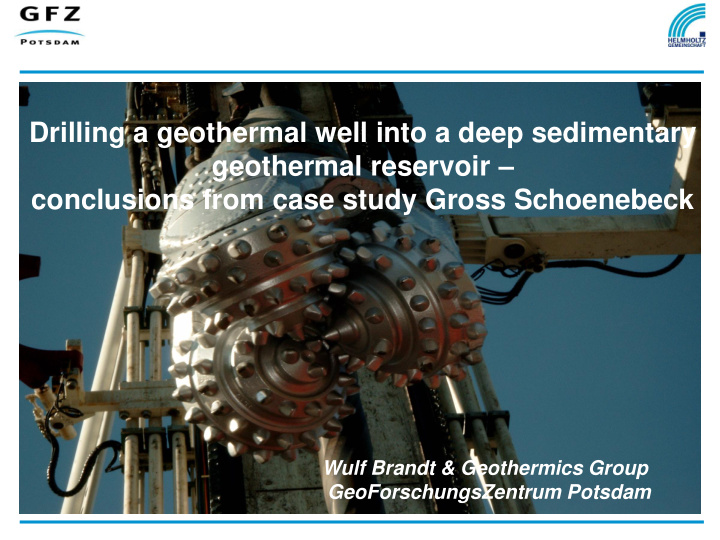



Drilling a geothermal well into a deep sedimentary geothermal reservoir – conclusions from case study Gross Schoenebeck Wulf Brandt & Geothermics Group GeoForschungsZentrum Potsdam
In situ Geothermal Laboratory Baltic Sea DB Kobenhavn Gross Schoenebeck North Sea PT NEGB Hamburg Warszawa NWGB NEB Berlin Rhenohercynian London Saxothuringian Bruxelles Praha front Moldanubian e n i p l A Paris 0 100 200 km Munich Rotliegend Caledonides & Alps Variszican older massifs belt (modified after Ziegler Precambrian 1990, Bertelsen 1992, Variszican Tornquist zone Caledonian crystalline Deformation front Deformation front Brecht 1999) basement
Operations overview open hole proppant frac Jan/Feb 2002 production test / logging 4130-4190m (frac 1) 4080-4118m (frac 2) production test / logging open hole waterfrac start Jan/Feb 2003 3874-4294m, borehole instability production test cont. Nov/Dec 2003 4135-4309m production test / logging Dec 2004 injection test April 2006 to Jan 2007 drilling 2. well
0n the way to an operating doublet well path of second well - designed as deviated well - in direction of minimum horizontal stress - to optimize performance of doublet aim - maximization of flow rate - for 30 years - avoid thermal short circuit scheduled fracture treatments - designed to achieve PI > 30 m³/(h*MPa) - sufficient for geothermal power production on economic level
EGS Gross Schoenebeck
Borehole Design of the Research Well
Lessons learned o drilling a large diameter borehole in sheet silicate bearing rocks (sequenzes of sand/sandstones and clay/mudstones) o directional drilling through and beneath rock salt formations with plastic behaviour o Adaptation to encountered geological conditions requires the variability of mud concepts with the goal of minimized formation damage
Large top hole diameter affected ROP Insufficient pumping capacity in the top hole region (23“) lead to bit balling resulting in a ROP of 4…7 m/h and an increased number of trips. Improper bit selection reduced ROP in the mesozoic section (16“).
disastrous cementation of 16“x13 3/8“ casing Total fluid loss occured during the cementation of the combined casing 16“ x 13 3/8“ despite of a slurry density of 1450 kg/m³ (Litefil by Schlumberger) due to plugging of the annulus by debris temperature logs 100 90 Conclusion: temperature while caliper logging before casing running 80 Free pipe will not temp. [°C] stand the thermally cement losses into temperature after cementation 70 Muschelkalk induced stresses to probable top of be expected 60 solid cement (buckling). temperature effects of 50 remained cement Free floating pipe is setting in caverns not acceptable. 40 0 500 1000 1500 2000 2500 depth [m]
Recovery of casing cementation To prevent casing damage in the future of the production well a reverse squeeze cementation through the annulus was designed and successfully performed: 1. Free point estimation and temperature logs squeeze cementation cement bond log verified top 85 10 of cement 80 8 Obviously no 2. Fluid loss annular flow 75 6 during injection temperature differences [K] 70 4 occurs near to temperature [°C] top of cement 65 2 3. Slurry density 60 0 22.9.06 before Frac of squeeze 23.9.06 after Frac 55 -2 23.9.06 before Cementing cement with 24.9.06 after Cementing DT vor/nach Frac 50 -4 1,30 below DT vor/nach Zem DT vor Frac bis nach Zem. density of mud 45 -6 700 800 900 1000 1100 1200 1300 1400 1500 1600 to be displaced depth [m]
Well design concepts for deep geothermal wells HDR Soultz EGS Groß Schoenebeck resp. geothermal wells in sediments non-suspended free floating fully cemented production casing partly cemented production casing suspended protective casing free moving production casing suspended at well head inside of polished bore receptable Pro´s successful cementing very likely no dislocation within the casing string low costs prevention of circulation behind the casing no thermally induced forces acting on the production string cost savings no buckling no tensile loads at the wellhead Con´s buckling unavoidable complete cement column must be secured annular circulation possible tightness problems possible very high tensional load due to casing motion required for avoiding buckling only applicable in solid rocks with no breakouts to be expected any fluid flow behind the uncemented casing must strictly be excluded
Casing collapse within the rock salt Ovality 8 mm 9 5/8“ liner collapsed during drilling into the target formation after reduction of mud density from 2000 kg/m³ to 1060 kg/m³ (Heavy deformation between 3880…3200 m)
Cause of collapse Casing design – according to the rules with an overburden pressure gradient of 2,3 Casing material – successfully inspected Anisotropic tension due to well path geometry – unlikely according to cross-correlation Anisotropic tension due to rock salt inhomogenities within the salt dome in connection with the geomechanical impact of drilling – not verifiable Anisotropic tension due to improper cementation of the deviated well – not very probable due to no. and positioning of centralizers and cementing procedure strictly following the simulation
Remedy for the collaps The loss of one casing dimension forced to adjust the borehole design – drilling of the Rotliegend section with 5 7/8“ and running and cementing of an combined 5“ liner with an uncemented section of preperforated pipes on bottom.
Conclusions Cost effective drilling of geothermal wells means Considering all costs emerging over the lifetime of the well Design the well as tall as possible but leave one ace upon your sleeve With highly corrosive fluids provide demountable coated or lined production/injection strings Particularly to geothermal producers and injectors adapted repair technologies for casings should be available
Tubingless insert ESP minimizes well diameter Is the geothermal „industry“ strong enough to demand such developments?
Repair of cemented casings Reasons • Internal corrosion due to air access during production/injection • Closing of perforations etc. (e.g. after secondary cementing) Means and technologies of expandables are to be worked out and assessed in cooperation with experienced players: Cladded liners (casing patch) Downhole coating of casing Downhole relining of casing with thin (folded) metallic liners
Recommend
More recommend